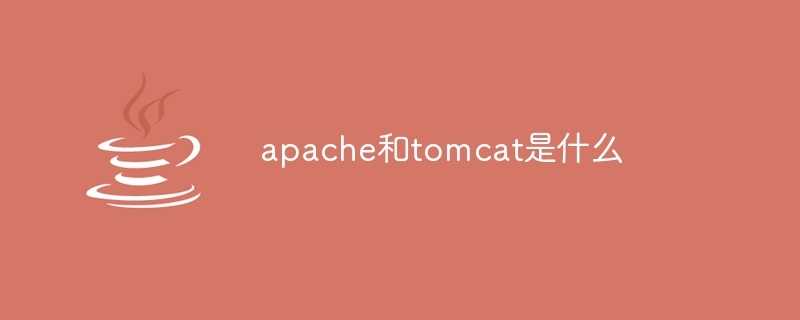
Apache and Tomcat are both widely used open source software, but they have some important differences in functions, uses, and architecture. Apache is a web server that mainly provides HTTP protocol services. It can parse static HTML pages and transmit them to the client through HTTP protocol. Tomcat is a Java Servlet container that provides an environment for running Java web applications.

The operating system for this tutorial: Windows 10 system, DELL G3 computer.
Apache and Tomcat are both widely used open source software, but they have some important differences in functions, uses, and architecture.
Apache is a Web server that mainly provides HTTP protocol services. It can parse static HTML pages and transmit them to the client through HTTP protocol. Apache is implemented in C language and is a process or thread model server that can create multiple processes or threads as needed to handle requests. Apache has strong scalability and can extend its functions through modules, such as adding the mod_rewrite module to implement URL rewriting functions. In addition, Apache also provides some security features, such as user-based access control and SSL encrypted communication.
Tomcat is a Java Servlet container that provides an environment for running Java Web applications. Tomcat can parse and execute Java Servlets, and return the results to the client in the form of HTML pages through the HTTP protocol. Tomcat is implemented in Java and uses Java's threading model to handle requests. Tomcat has a wide range of applications and is part of the Java EE specification, so it can support various Java class libraries and frameworks. Tomcat also provides some security functions, such as JASPI (Java Authentication SPI) and JAAS (Java Authentication and Authorization Service), which can be used to implement single sign-on and permission management.
Apache and Tomcat can be used together to form the Web server architecture of Apache Tomcat. In this architecture, Apache is responsible for providing delivery of static content, while Tomcat is responsible for handling dynamic content for Java web applications. This architecture enables seamless integration of static and dynamic content, improving system performance and stability.
Apache and Tomcat are significantly different in many aspects:
1. Functions and uses: Apache is a web server that mainly provides HTTP Agreement services. It can parse static HTML pages and transmit them to the client through HTTP protocol. Tomcat is a Java Servlet container that provides an environment for running Java web applications. Tomcat can parse and execute Java Servlets, and return the results to the client in the form of HTML pages through the HTTP protocol.
2. Implementation method: Apache is implemented in C language. It is a process or thread model server that can create multiple processes or threads as needed to handle requests. Tomcat is implemented in Java. It is a Java-based web container that uses Java's threading model to handle requests.
3. Scalability: Apache and Tomcat both have good scalability, but their expansion methods are slightly different. Apache can extend its functionality through modules, such as adding the mod_rewrite module to implement URL rewriting functionality. Tomcat implements dynamic content generation through JSP (JavaServer Pages) and Servlet, and supports various Java class libraries and frameworks.
4. Integration: Apache and Tomcat can be used together to form the Web server architecture of Apache Tomcat. In this architecture, Apache is responsible for providing delivery of static content, while Tomcat is responsible for handling dynamic content for Java web applications. This architecture enables seamless integration of static and dynamic content.
5. Performance and stability: Apache has higher performance and stability in processing static content, while Tomcat has higher performance and stability in processing dynamic content. Therefore, when choosing to use Apache or Tomcat, you need to weigh performance and stability considerations based on actual needs.
6. Security and firewall: Apache provides some security features, such as user-based access control and SSL encrypted communication. Tomcat also provides security functions, such as JASPI (Java Authentication SPI) and JAAS (Java Authentication and Authorization Service), which can be used to implement single sign-on and permission management. Additionally, Apache or Tomcat can be deployed behind a firewall to protect web applications from unauthorized access and attacks.
7. Community and support: Apache and Tomcat are both open source software and have huge communities and support resources. However, since Tomcat is part of the Java EE specification, it is more widely used and more strongly supported.
To summarize, Apache is a Web server that mainly provides HTTP protocol services and the transmission of static content. Tomcat is a Java Servlet container used to provide a running environment for Java Web applications. Both can run as standalone web servers, but Apache cannot interpret Java programs (jsp, servlet). They can be selected and configured according to actual needs to achieve optimal performance, stability and scalability.
The above is the detailed content of What are apache and tomcat. For more information, please follow other related articles on the PHP Chinese website!




